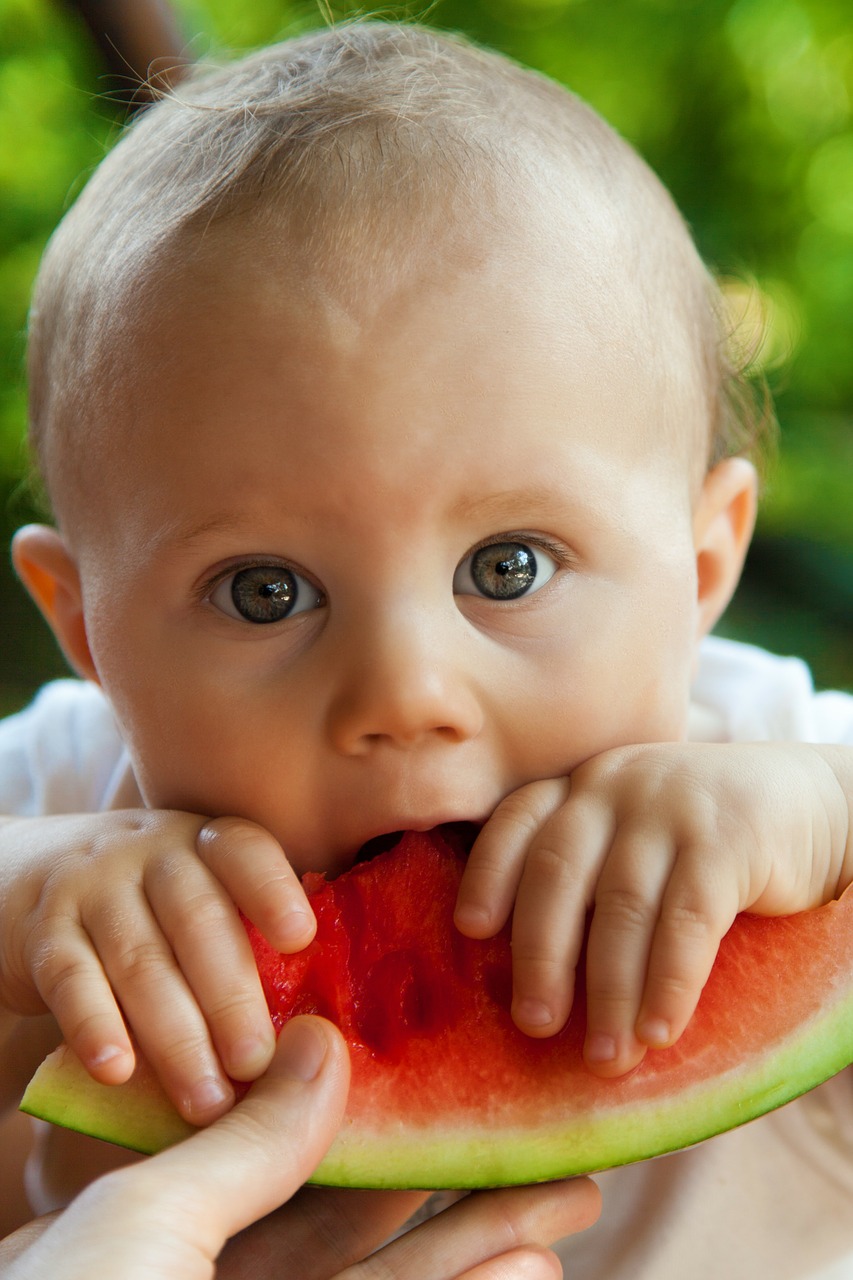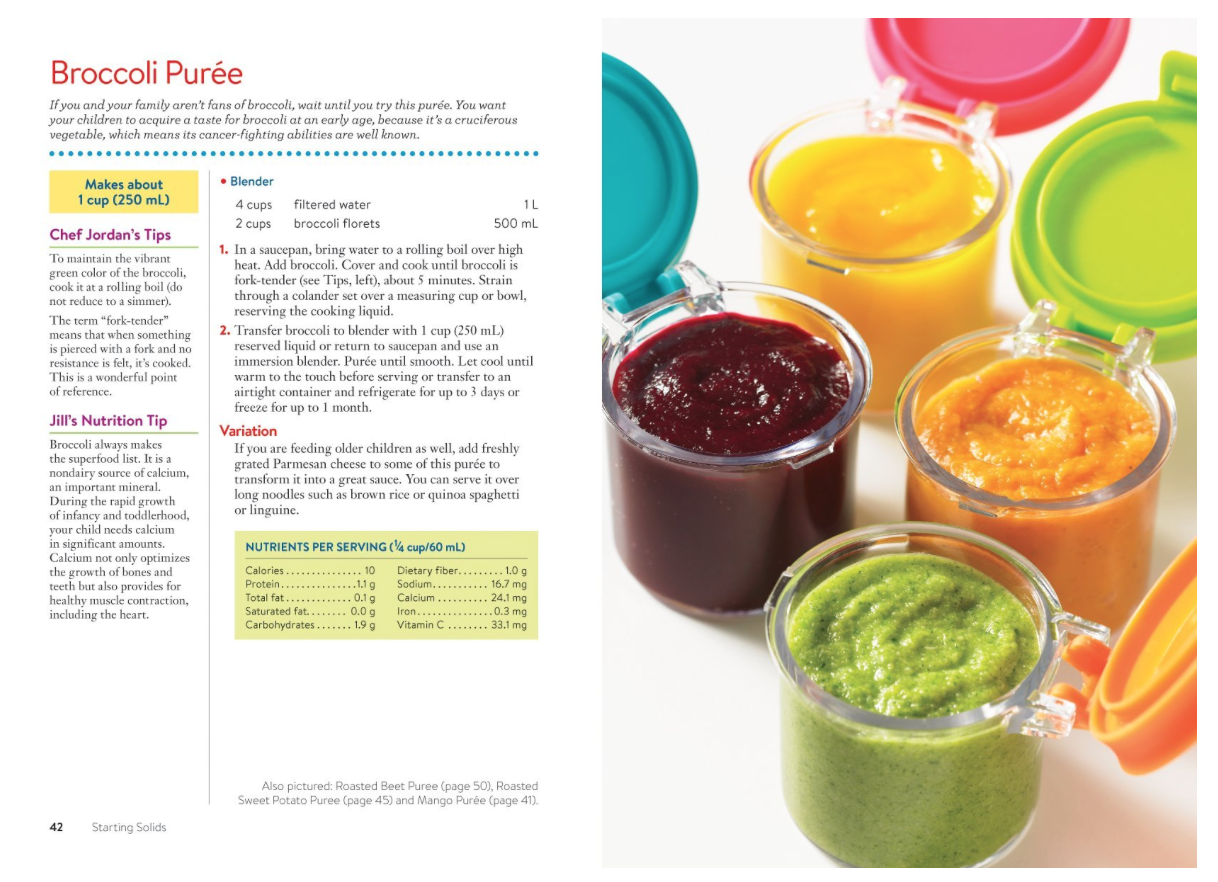
The transition from breastmilk or formula to solid food can be an exciting one. Advice varies from beginning solid food when baby’s first teeth emerge to waiting until six months of age. The standard first food is runny rice cereal (my midwives advised mixing it with breastmilk to make the transition easeful). Next single food purrees are introduced one a time.
There are alternatives to this standard advice (see BABY ESSENTIALS THAT AREN’T, PART 7: BABY FOOD for information on baby led solids); however, one thing is not debatable…homemade baby food is nutritionally better than the stuff in cute little jars.
Making your own baby and toddler food is really easy, but it can be frustrating. Sometimes your child refuses what you feed them. That is normal.
Did you know that it takes 6 to 10 trials of new foods before a baby will accept a new flavor or texture?
 We were sent a book with lots of recipes and wise advice about feeding your baby and toddler. The Best Baby Food: 125 Healthy and Delicious Recipes for Babies and Toddlers by Jordan Wagman and Jill Hillhouse is a comprehensive resource on nutritional information, easy recipes, and tips for feeding your child.
We were sent a book with lots of recipes and wise advice about feeding your baby and toddler. The Best Baby Food: 125 Healthy and Delicious Recipes for Babies and Toddlers by Jordan Wagman and Jill Hillhouse is a comprehensive resource on nutritional information, easy recipes, and tips for feeding your child.
The recipes are broken down according to age beginning with 6 to 9 months which is when most babies can begin to transition to more solid food:
For 6 to 9 months: Apple Medley, Brown Rice Cereal, Nectarine and Carrot Purée, Tofu, Bosc Pears and Banana, Basic Quinoa, Caramelized Parsnip Purée, Banana and Blueberry Purée
For 9 to 12 months: Stewed Leeks with Butter, Soft Polenta with Cheddar Cheese and Broccoli Florets, Pacific Salmon Cakes, Oven-Roasted Chicken with Dried Apricots, Diced Potato Gratin
For Toddlers 12 months+: Roasted Summer Fruit Smoothie, Best-Ever Barbecued Corn, Warm Barley with Fresh Herbs and Parmesan Cheese, World’s Best “Fish Sticks”, Pork with Red Cabbage.

Did you know that if you feed your baby a variety of nutritious foods its first year you will prevent them from becoming a picky eater?
In addition to the recipes, The Best Baby Food: 125 Healthy and Delicious Recipes for Babies and Toddlers discusses important nutritional considerations such as allergies and fats. Breastmilk is 50% fat, so this is an important element of your child’s diet. Furthermore, the authors recommend organic, nutrient dense food for your baby and toddler.
4 Reasons why organic, home made food is better for babies and toddlers
Babies are more susceptible to the negative effects of toxins, including pesticide residues, due to their small size and growth. According to the authors, a child’s cells are multiplying “at their peak”, as well as vital organ devleopment is occurring. These immature organs, especially the ones used for detoxification like the liver and kidneys, are less able to break down and metabolize toxins than an adults.
1. The United States Environmental Protection Agency found that toxins are on average 10 times more potent for babies than adults.
2. Recent studies by the United States Department of Agriculture 85% of 10,187 food samples tested contained pesticide residue.((http://www.ecowatch.com/usda-pesticide-exposure-2105041546.html?utm_source=EcoWatch+List&utm_campaign=dd825a54f2-MailChimp+Email+Blast&utm_medium=email&utm_term=0_49c7d43dc9-dd825a54f2-85357185))
Given that this pesticide residue is 10 times more toxic for babies, it is clear that organic food is best.
3. Organic food is nutritionally superior
Organic food is nutritionally superior to conventional food.
Researchers at Newcastle University in England have found that organic crops overall contain 17% more key anti-oxidants than non-organically grown crops, while some classes of anti-oxidants known as flavinones, were found at a rate 69% higher. Anti-oxidants are components in fighting cancer and are thought to play a key role in preventing heart disease and neurodegenerative disease.((http://eyr.lil.mybluehost.me/2014/07/20/more-proof-organic-food-is-better/))
Given the small amounts that babies and toddlers eat, it only makes sense to feed them food that packs in more nutrition.
4. Processed baby food is less nutritious
According to The Best Baby Food: 125 Healthy and Delicious Recipes for Babies and Toddlers,
When ingredients such as vegetables are processed, they may lose essential nutrients. In addition, many commercially prepared baby foods contain additives that can affect the nutrient content of the food. For instance, a 1995 report by the Center for Science in the Public Interest compared fresh apricots to jarred ones from a leading baby-food manufacturer. They knew that, according to the USDA Food Database, one 4-ounce serving of fresh apricots provides about 335 mg of potassium and 2860 IU of vitamin A. By contrast, they found that one 4-ounce serving of jarred apricots contained only 139 mg of potassium and 1333 IU of vitamin A-a considerable difference.
Making your own baby food is super simple. It does not really require a cookbook or special equipment. Simply steaming fruits and vegetables until soft and then mashing them is all you need to do. Books like The Best Baby Food: 125 Healthy and Delicious Recipes for Babies and Toddlers are helpful to give you ideas and confidence as you make healthy meals for your child.
Leave a Reply